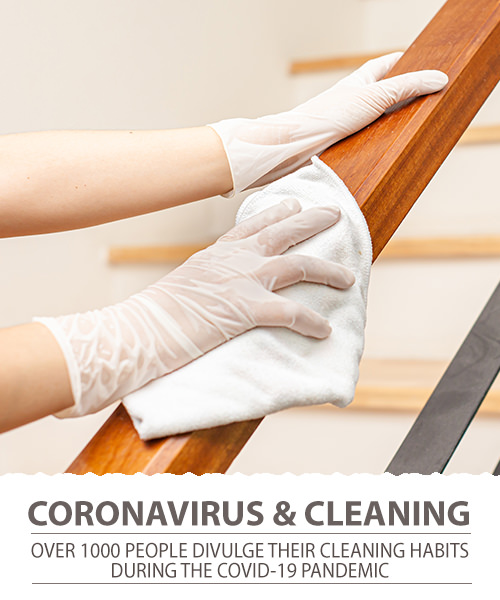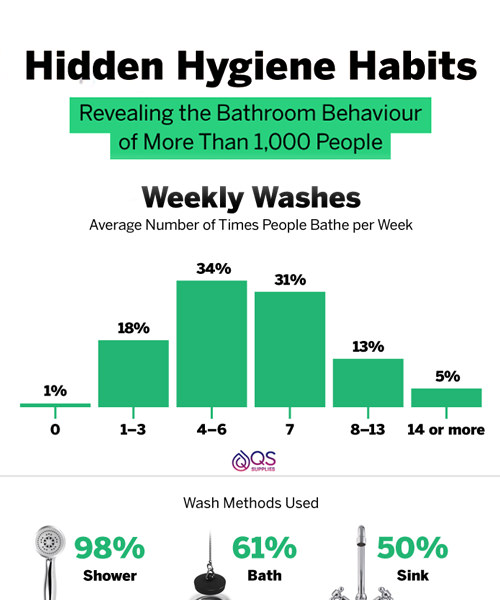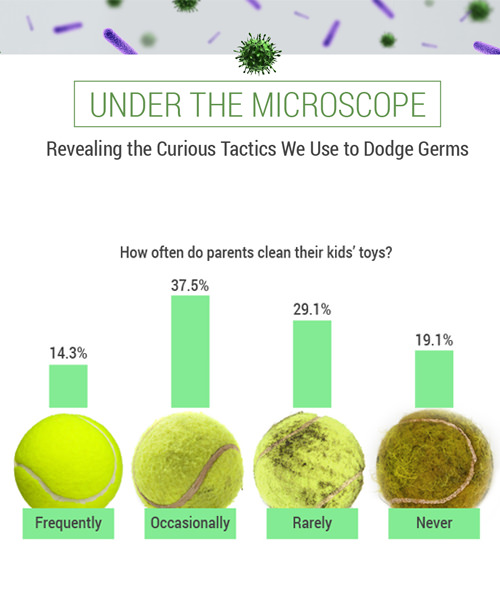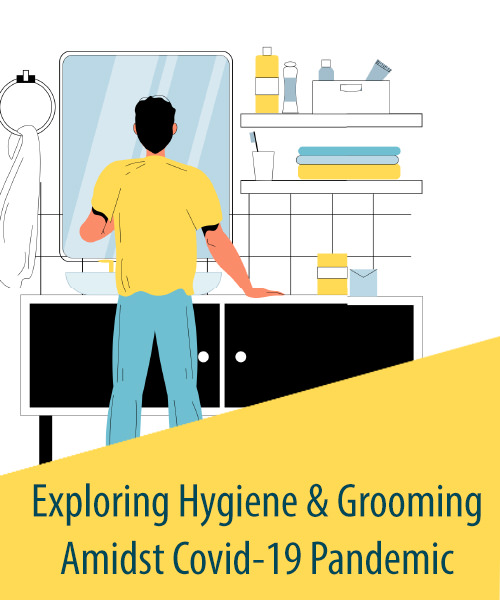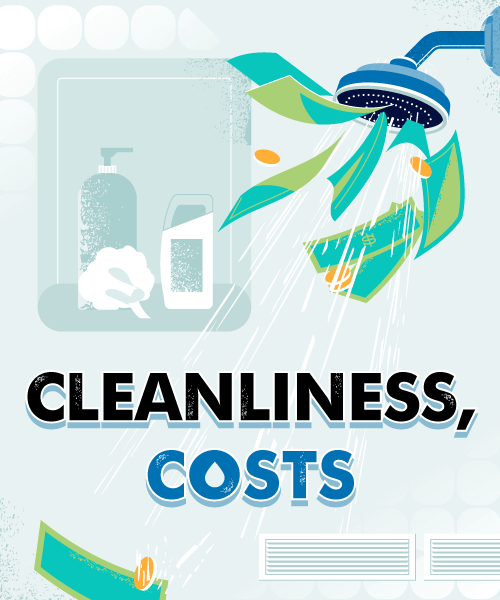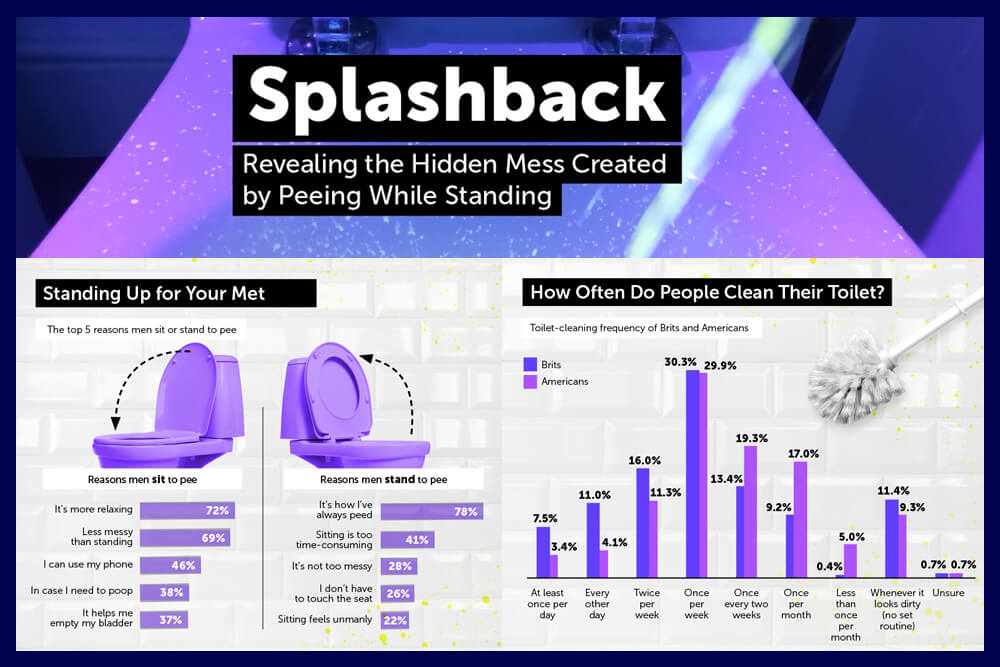
- When at home, 7 in 10 men said they usually pee standing rather than sitting.
- We simulated standing urination under UV light to observe the droplets and mist created, and in every simulation, we found that peeing while standing covers the toilet and surrounding area with splashback that usually remains unseen.
- Men who pee while standing most often aim at the rear wall of the toilet bowl (31% of men) and believe this surface minimises mess – but we found it creates more unseen splashback than any other aiming technique.
- The furthest distance a droplet flew during our tests was 36 inches – nearly 1 metre. One in 4 people we spoke to said their toothbrush was within this distance.
- Roughly 1 in 3 men and 1 in 5 women think it’s ‘unmanly’ if a man usually sits to pee.
- But faced with the reality of splashback their standing urination creates, one-quarter of men would consider sitting down more often in the future.
The toilet is surely the most contentious piece of furniture in the home. Shared by all but visited alone, the way we use (and sometimes abuse) our lavatories is an endless source of debate between men and women.
Much of water closet controversy comes from women’s exasperation at men when they sometimes leave the seat up. But here’s an arguably more fundamental question to consider – should men ever lift the seat to allow for standing urination, or should the toilet strictly be something we sit on, not aim at?
We used ultraviolet light and dozens of urination simulations to reveal the true extent of the splashback that’s created by men when they pee standing up.
Watch the Video Here: https://www.youtube.com/watch?v=ejl7vrDUIcs&t=15s
To guide our splashback simulations, we first surveyed 1,019 people and asked them how they use their toilet, their opinions on standing versus sitting to pee, and how often they clean their commode.
Just 1 in 5 men sit when they pee
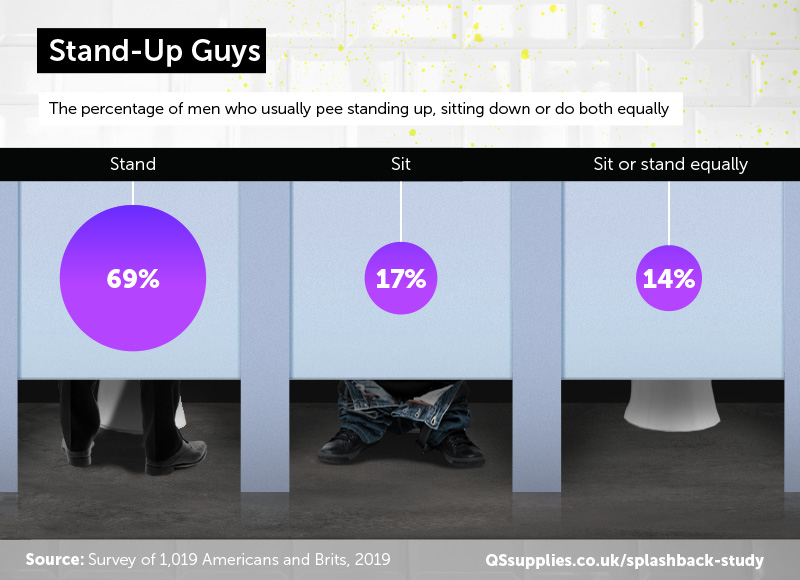
When at home, 7 in 10 men said they usually pee standing rather than sitting. In fact, only 17% usually sit down to urinate. These figures come from our survey of British and American people, which included 680 men. There’s evidence that elsewhere in the world men have significantly different peeing preferences.
In Japan, a 2018 poll of 300 men aged 20 to 69 revealed that 29.3% took a seat when they peed, significantly more than the 17% among those we quizzed. Among Japanese men in their 30s, 41.5% were exclusively sitters versus just 12% of our participants. An earlier study in Japan from 2007 put the proportion of sitting urinators at 49%. A spokesperson for Matsushita Electric Works, who conducted the survey, said at the time, ‘The chances of spraying the seat are much higher when you stand up, and many women hate cleaning up the mess’.
It’s clear that standing to urinate is the overwhelming preference of men in Britain and America.
So what really happens each time a man aims into the toilet bowl?
Standing urination splashes pee onto nearby walls
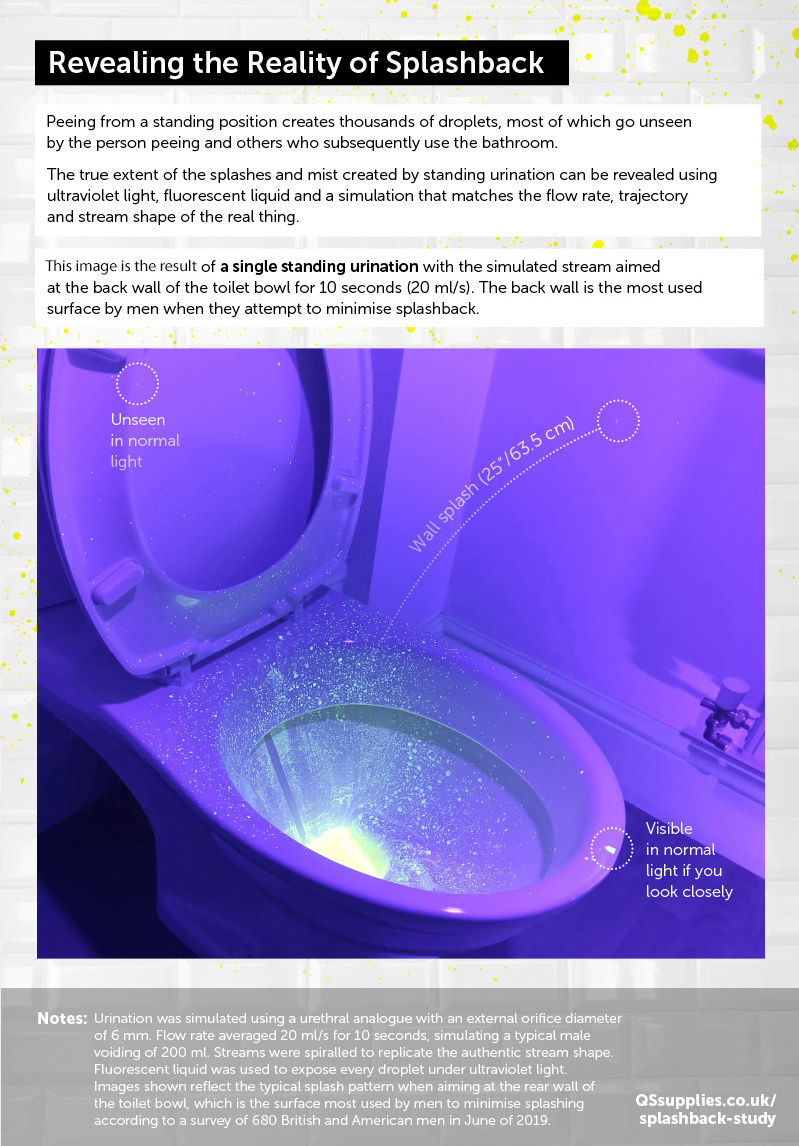
A certain amount of splashing when using the toilet is inevitable, whether you stand or sit. For instance, there’s the unsettling upward ‘sploosh!’ that can catch you by surprise when – well, we won’t elaborate.
But aside from unlucky sitting splooshes, there’s an unseen world of splashback created when men stand to pee. We aren’t talking about drunken misfires or unexpected ‘forked streams’. Every time a man pees into a toilet bowl while standing, thousands of droplets, most of which are small and can’t be easily spotted, bounce and fly around the bowl onto the underside of the seat (if it’s up) and even further afield.
We know this because our researchers spent six weeks measuring and recording the splashback created when a urine stream hits various surfaces of the toilet bowl.
Usually, splashes are only noticed by the man who’s peeing or the person who uses the bathroom after him if large droplets happen to fly onto the seat or floor, but by using ultraviolet light and fluorescent liquid, we exposed droplets of every size and exactly where they flew.
Urine is only visible under ultraviolet light when dry, so we had to simulate streams accurately using fluorescent liquid and a mechanical urethra. That meant faithfully reproducing every element of typical standing urination, including volume, flow rate and curve, trajectory and stream shape.
Once our urination analogue was successfully benchmarked against the output of a healthy adult male (20 ml/s for an average duration of 10 seconds per visit), we simulated dozens of streams from a standing position.
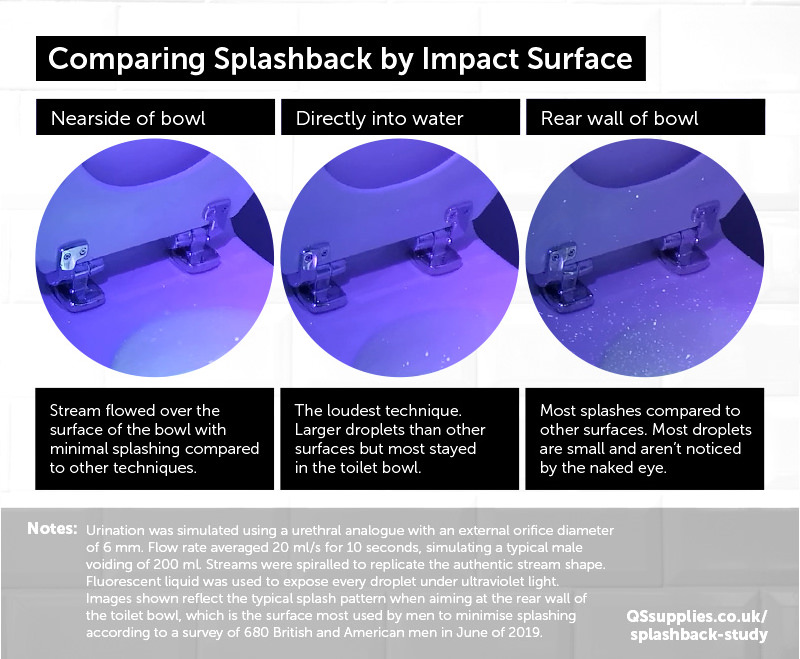
Streams aimed at and around the rear wall of the toilet bowl produced the most droplets and the widest spread.
As it happens, this is the surface that men told us they most often aim at because they believe it’s best for minimising splashback. In fact, rear-wall aimers (31% of men who at least sometimes stand to pee) could be inadvertently maximising the mist of pee their stream creates.
The next most commonly employed method for reducing splashback is aiming directly into the water. 29% of men use this approach. In our tests, aiming into the water prevented excessive splashing of tiny droplets and created a smaller number of large drops. These mostly stayed within the toilet bowl but sometimes flew onto the rim or further.
The surface that produced the fewest airborne droplets and smallest spread was the nearside of the bowl, just in front of the water. But most men we spoke to didn’t guess that would be the case – only 4% believed the nearside would create the least splashback.
We tested two models of toilet, but it’s possible that other designs with different interior angles would produce different splash patterns. (‘Poo shelves’ are common in Germany, for example.)
Nevertheless, in every simulation, no matter which surface we aimed at, the UV light revealed some number of droplets flying onto the toilet rim, the underside of the toilet seat and lid, the floor or all of the above.
The only thing missing from our simulations was a replication of men’s favoured finishing method, which, if anything, would create more splashback. 77% of men who pee standing up said they finish with a shake. Around 1 in 4 use tissue as part of their finishing routine, compared to 46% of men who prefer to sit.
The significance of unseen rogue urine splashes largely depends on how people feel about the concept of pee accumulating on and around their toilet, as well as how often they clean their bathrooms, so we looked into both questions.
Americans are 12 times more likely than Brits to clean the toilet less than once per month
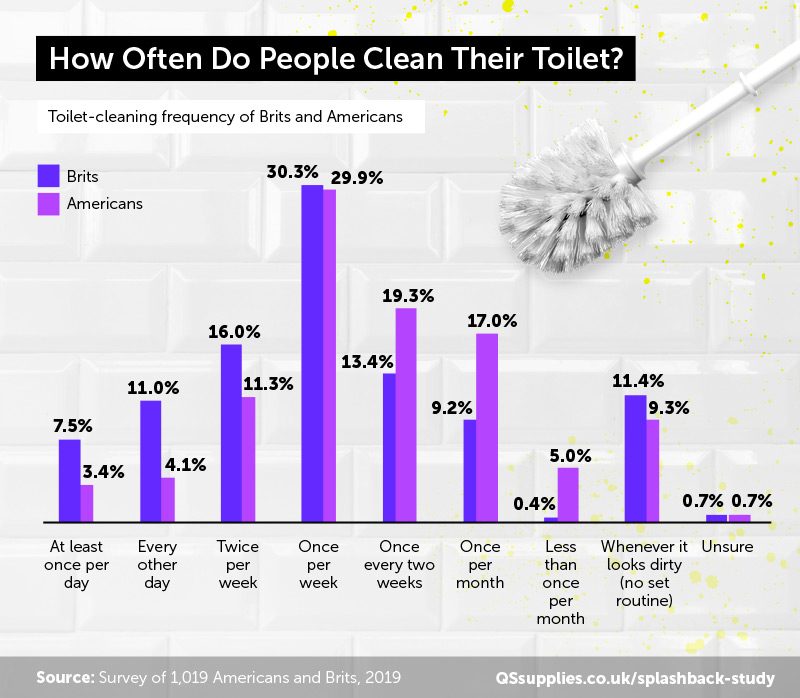
Ninety-two percent of women and 86% of men told us that the idea of accidentally touching their own dried pee (e.g., while lifting the toilet cover) bothers them to some degree. Twenty-one percent of women and 17% of men said the idea ‘strongly disgusts’ them.
The numbers were understandably higher when imagining touching the urine of someone you live with. Thirty-seven percent of cohabiting women and 23% of men were ‘strongly disgusted’ by this.
It’s a thought-provoking predicament, given that the most common toilet cleaning frequency among Brits and Americans is once per week.
Less than 1 in 10 households clean their toilet every day (with Brits more than twice as likely as Americans to claim they do so). This means that – based on the number of unseen splashes we witnessed in our tests created by a single standing urination – there’s ample opportunity for pee to accumulate on and around the toilet between cleanings.
To see exactly how much builds up, we simulated 10 standing urinations to represent five days’ worth of standing peeing (assuming two visits per day).
10 standing urinations is enough to cover the toilet, floor and nearby surfaces in invisible pee splashes
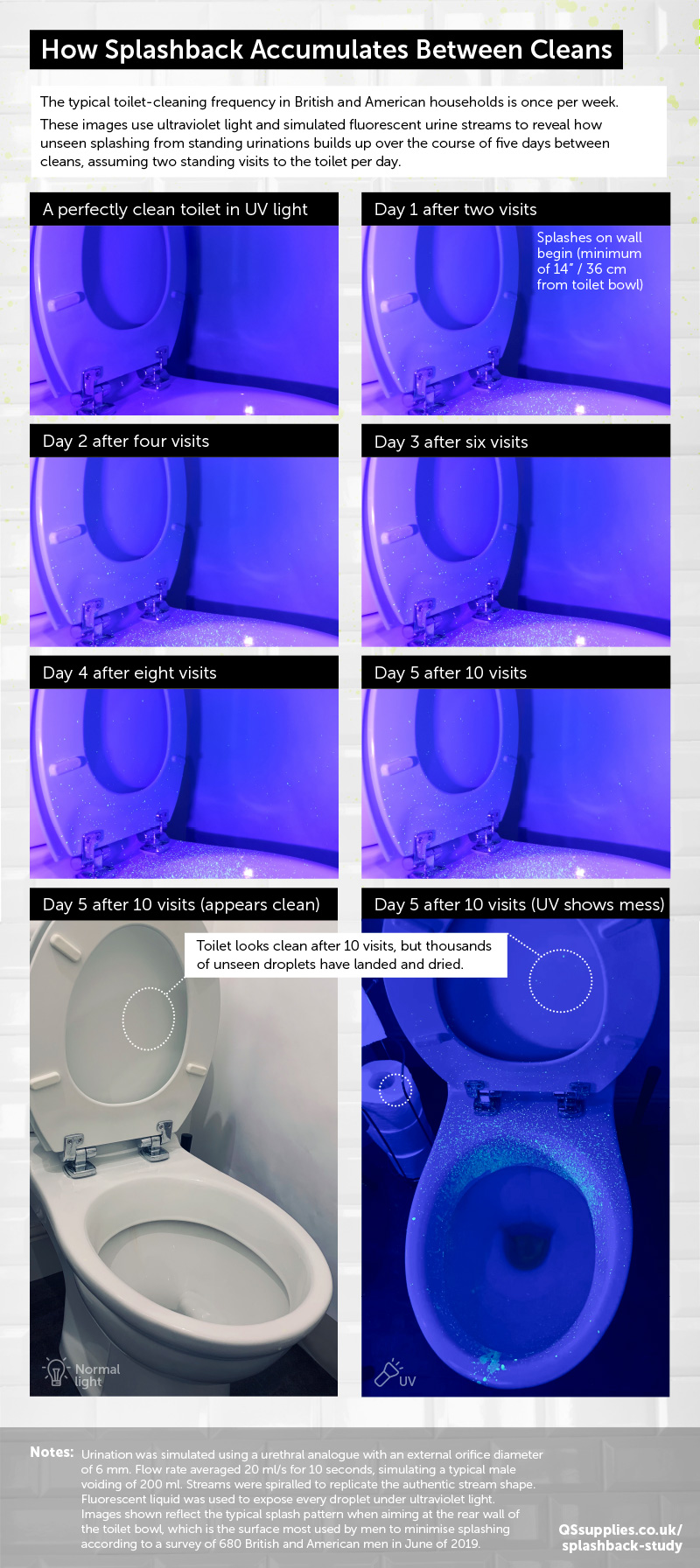
We based our splashback accumulation test on two standing urinations per day for five days. As mentioned earlier, the most common toilet-cleaning schedule is once per week, which means the spray patterns shown in the day five images above represent what a typical toilet would look like if you could see where every droplet of urine landed throughout the week.
It’s important to note that after 10 visits, the toilet under normal light looked entirely clean. It’s only when the thousands of tiny droplets are illuminated under UV light that the full extent of a week’s worth of splashback becomes obvious.
In our testing setup, there was a wall just over 1 foot from the toilet bowl. Using the most popular contact surface among men (the rear wall) in each visit, splashes hit the bathroom wall every time. The furthest distance a droplet flew was 36 inches – nearly 1 metre. Tiny splashes were also found on a roll of toilet paper close by and the underside of the sink basin, which was directly next to the toilet.
Eighty-six percent of people we spoke to who lend a hand in the toilet cleaning at home said they don’t routinely clean areas surrounding the toilet, such as a nearby wall.
One in 4 people told us that their toothbrush was within arm’s reach while sitting on the toilet, which means flying urine droplets could have reached it within 10 visits to the bathroom.
Most people are bothered if not disgusted by the idea of touching another person’s pee and we’ve seen that touching it, albeit probably without realising it, is practically inevitable unless the toilet is completely cleaned after each standing urination. With these facts in mind, do men acknowledge the amount of mess they create by standing to pee?
Men are 7 times more likely than women to say they create more of the toilet mess in their household than others
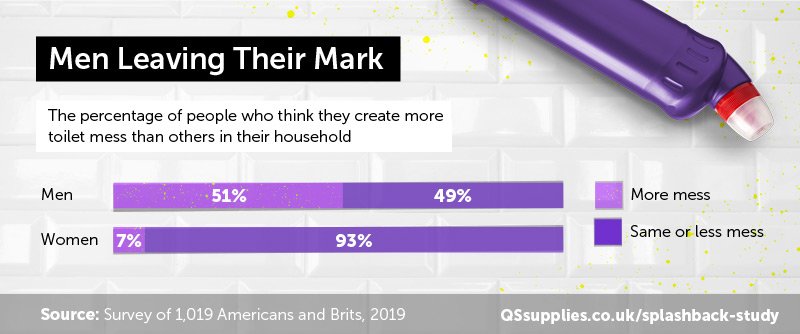
Half of men said they believe they are personally responsible for more toilet mess than the people they live with, compared to just 7% of women. More specifically, among men who cohabit with only female partners, 63% said they make most of the toilet mess, whereas only 13% of men who live with other men but no women said the same.
However, men who live with a female partner were almost three times more likely than women who live with one man (36% vs. 13%) to say someone other than them does most of the toilet cleaning. In other words, most men who live with women acknowledge they create most of the toilet mess because they pee standing, yet don’t – according to our findings – hold the role of main toilet cleaner.
When we asked how men felt about their standing urinations creating more splashback than if they were sitters, 10% denied that standing creates more mess (our tests suggest otherwise), 1 in 5 said they feel ‘a little bad about it’ 65% said they have no negative feelings at all, and only 3% said they feel very bad about it. (However, this was before we showed them the UV photos depicting the true extent of splashback caused by standing urination – more on this later.)
Nine out of 10 men acknowledged that peeing standing is messier than sitting. So why do only 17% always take a seat?
8 in 10 men say they pee standing because it's how they've always done it
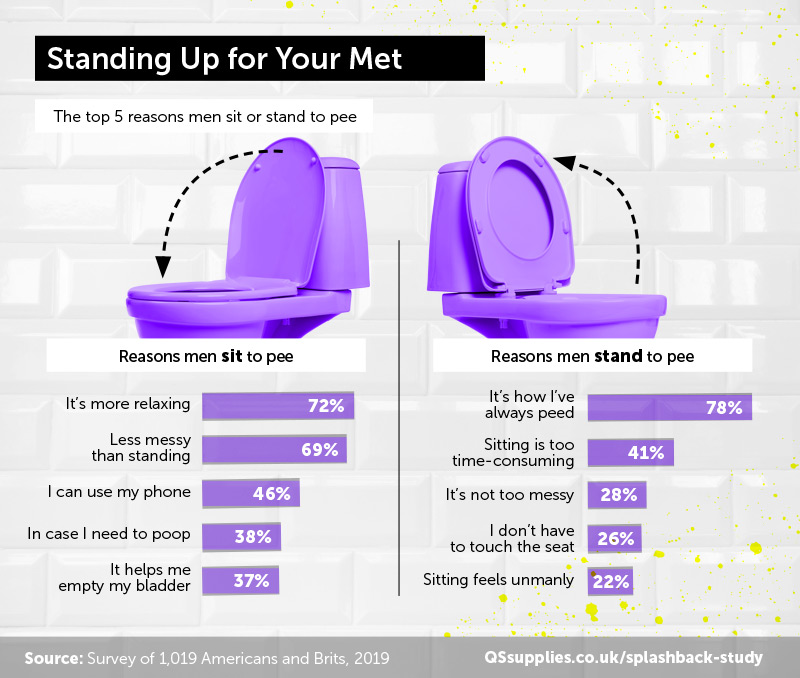
We already know the army of standers outnumbers the sitters 5-to-1. But do the standers have good reasons for belonging to the messier faction? Seventy-eight percent of men who stand to pee said they do it because it’s what they’ve always done.
The next most common reason for taking aim instead of taking a seat is because standers believe sitting is too time-consuming (41%), while 28% simply don’t feel standing urination creates enough mess to justify switching sides.
The sitters cite the relaxation of taking the weight off their feet as the main reason they don’t stand (72%), and 69% believe that standing is, in fact, messy enough compared to sitting to justify the latter. There are other practical benefits to sitting too – 1 in 4 sitters say it’s useful sitting down to pee in case it turns out they need to upgrade from a number one to a number two, and 46% say they like to use the relaxing opportunity to spend time on their phone.
Most reasons on both sides are understandable, if not justifiable, in light of our test results, except for one. Twenty-two percent of men said they pee in a standing position because sitting would make them feel ‘unmanly’.
1 in 5 women think it's unmanly if a man sits to pee
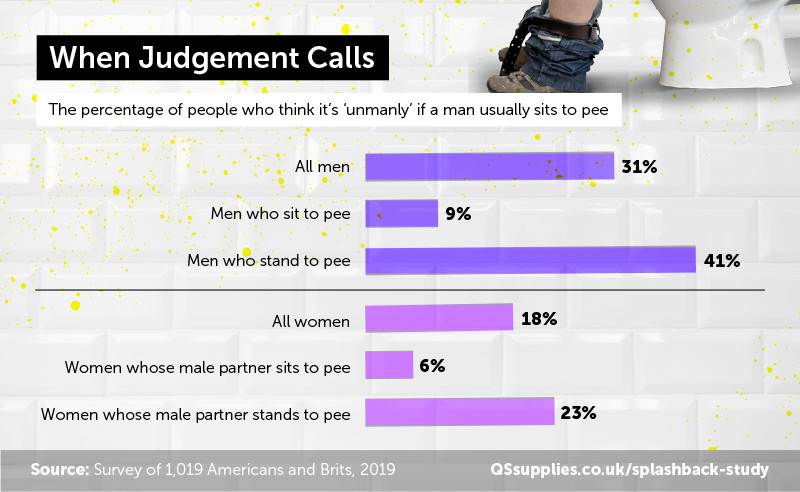
In Germany, if you sit down to pee you might be called a ‘Sitzpinkler’ which roughly translates as an unmasculine wimp or wuss. However, that doesn’t mean standing to pee is the social norm. In fact, ‘Stehpinklers’ (those who pee standing) are frowned on in many households. Some bathrooms even contain red traffic-style signs forbidding the standing position. So you’re damned if you sit and damned if you stand.
In 2015, a German judge presided over a case in which a landlord sued his Stehpinkler tenant for damaging his marble floor with urine splashes. The judge commented, ‘Despite growing domestication of men in this matter, urinating while standing up is still common practice’. The landlord lost the case.
Thirty-four percent of British men and 26% of American men we polled said they think sitting to pee is unmanly, but opinions differed depending on which camp they belonged to. Only 9% of sitters think it’s unmanly, whereas 41% of standers believe sitting to pee makes a man less masculine.
Women were less judgemental, with 18% overall believing a man sitting is unmanly, with a noticeable bias depending on whether their partner stands or sits. Twenty-three percent of women whose partners stand to pee believe sitting to empty one’s bladder is an unmanly act compared to 6% in the opposite camp.
1 in 4 men who usually stand to pee would consider sitting more in future after seeing the full extent of the splashback they create
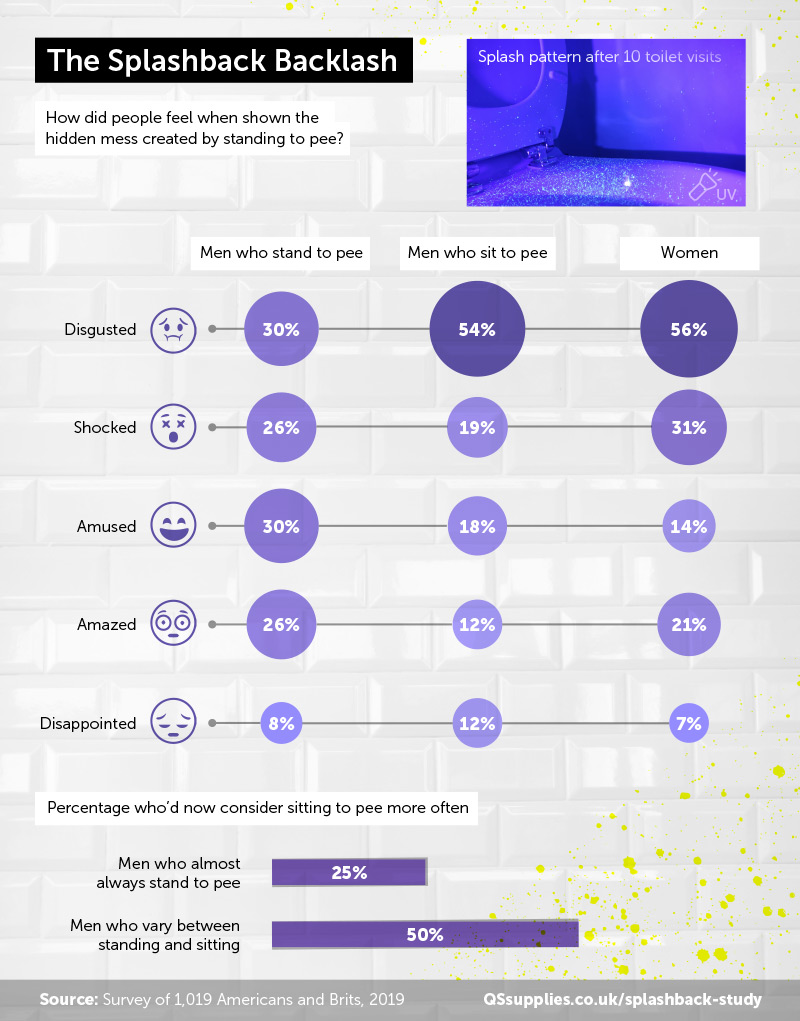
For most men who pee standing (and those they live with), ignorance is bliss. The majority of splashback goes unnoticed unless one looks very closely in normal light or reveals every drop and drip using UV.
However, more than 1,000 people’s blissful ignorance has now been wiped away, as we showed them the photos you see on this page. Men who stand to pee were less likely to be strongly affected by the findings than men who sit and women who cohabit with male partners who sit, but 30% of standers nevertheless said they were disgusted by what the UV light revealed, 26% were shocked, and 30% were amused. Standers were more than twice as likely as women to say they were amused by the extent of the splashback they cause. Fifty-six percent of women said the results disgusted them.
According to the saying, sunlight is supposed to be the best disinfectant. In this case, it appears ultraviolet light might be. One-quarter of men who stand to pee said, having seen our photos of the amount of unseen splashback their bathroom visits create, they would now consider sitting to pee more often. Among men who already mix standing and sitting, depending on their mood, half said they’d now be more likely to hunker down.
Summary
Our standing urination simulations reveal a world of splashback that usually goes completely unseen. But between toilet cleanings, thousands of urine droplets have the potential to cover most of the toilet, including front-facing flush handles, which are found on 4 in 10 toilets according to our findings. Splashes can also hit the floor and nearby sinks, walls, and radiators.
When we simulated a man’s seated urination, there were significantly fewer splashes and they were confined to the underside of the front of the toilet seat (droplets bouncing up from the nearside of the bowl) and the front rim, as shown in the image below.
Peeing while sitting creates minimal splashback compared to standing urination
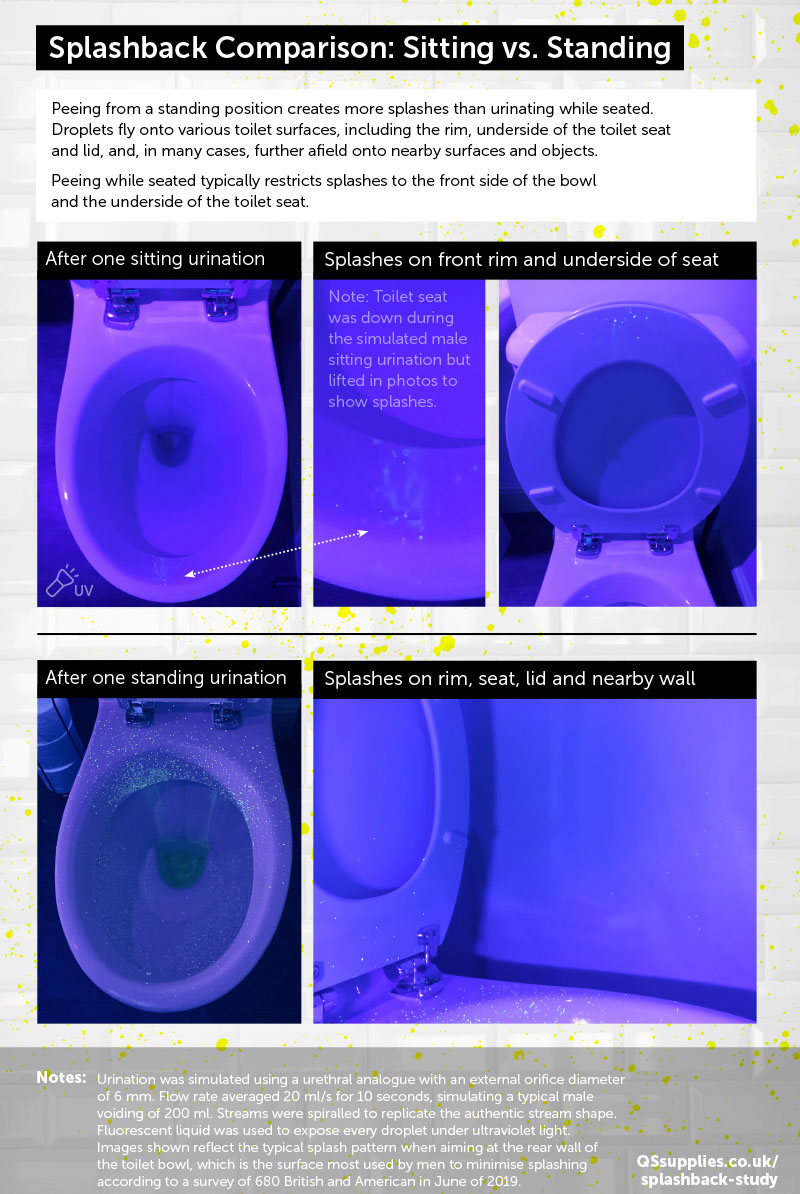
So peeing while seated doesn’t remove splashback completely, but it does prevent droplets from flying out of the bowl onto the top rim of the toilet, the underside of the lid and further afield onto the floor and walls and potentially flush handles, toilet rolls, sinks, and toothbrushes.
Contrary to popular belief, urine isn’t sterile, but that doesn’t necessarily mean the bacteria it may contain are harmful. For most of us, it’s the idea of pee flying everywhere that bothers us. Based on our tests, strategically choosing the surface the stream contacts can help, with the rear wall the most splash-producing and the nearside the least, although your mileage may vary based on your height, personal peeing power and the shape of your toilet bowl.
All things considered, there’s only one sure-fire way to take a strong stand against splashback – and that’s to take a seat.
Methodology
Standing urination was simulated using a urethral analogue with an external orifice diameter of 6 mm. Flow rate averaged 20 ml/s for 10 seconds, simulating a typical male voiding of 200 ml. Streams were spiralled to replicate the authentic stream shape. Fluorescent liquid was used to expose every droplet under ultraviolet light.
Images shown, except where otherwise noted, reflect the typical splash pattern when aiming at the rear wall of the toilet bowl, which is the surface men most commonly aim at and believe causes the fewest splashes according to a survey of 680 American and British men by QS Supplies in June of 2019.
Images were chosen from a larger selection taken during testing to be as representative of typical standing urination as possible. Flow curve, which is the speed at which urine is expelled from beginning to the end, was mimicked as closely as possible but wasn’t controlled in isolation as closely as flow rate, angle, and impact location. Shaking of the penis, which is the most common method used by men to void last urine drops, was not part of the simulation. This means a few more flying droplets could be created than are shown in the images.
Although toilet design is undoubtedly a large factor in how much splashback is created by standing urination, under ultraviolet light, every angle and surface we tested across two toilets resulted in splashes leaving the toilet bowl.
Fair Use Statement
We’d love for you to share our findings and images for noncommercial purposes. All we ask is that you link back to this page to give readers access to the full findings and credit to the QS Supplies research team.

